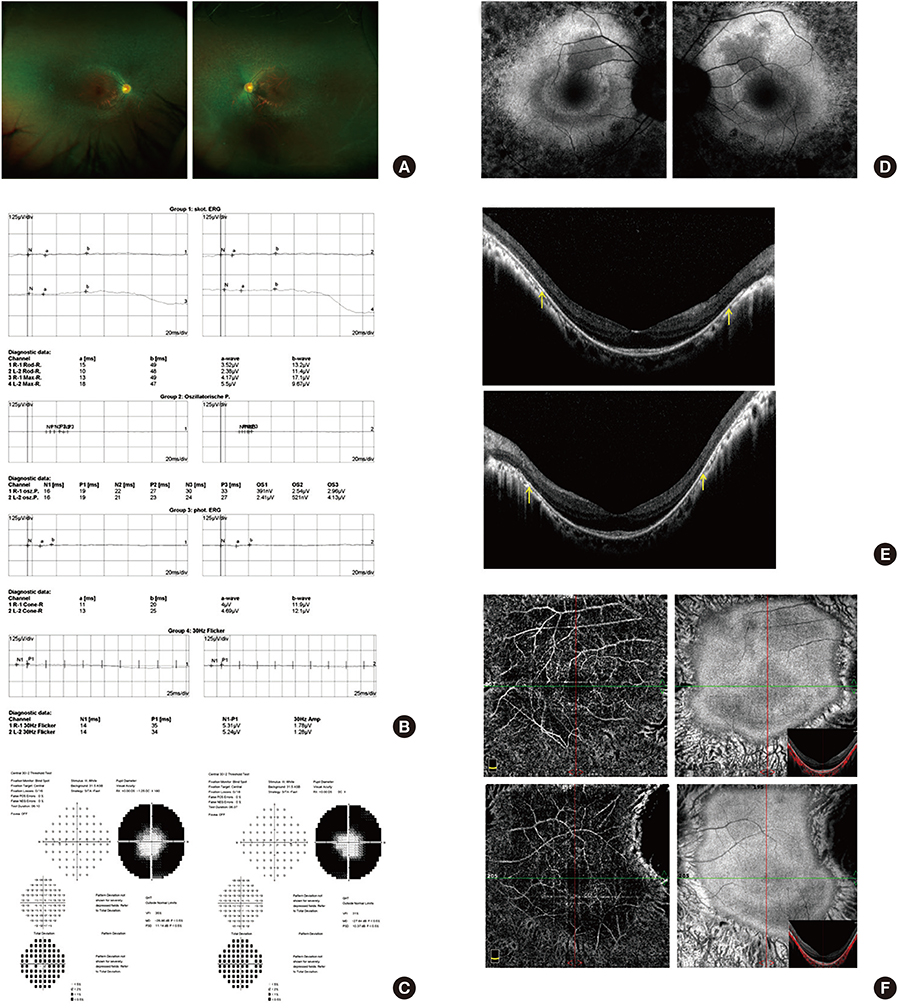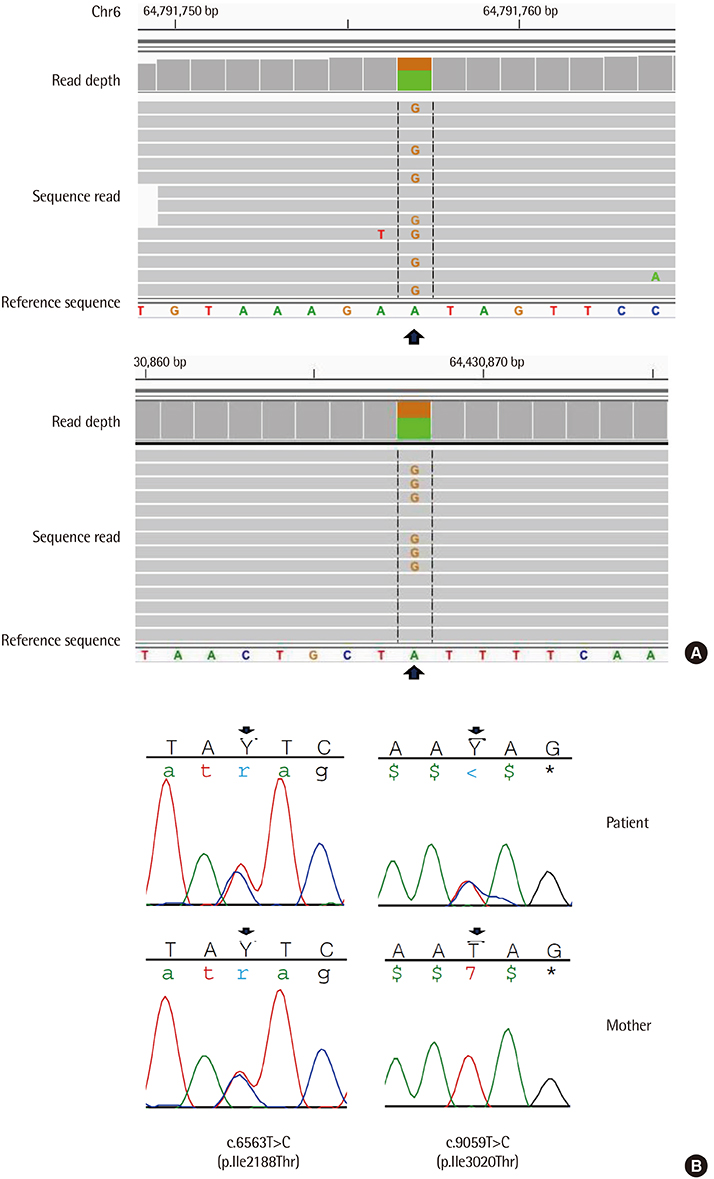Lab Med Online.
2018 Apr;8(2):66-70. 10.3343/lmo.2018.8.2.66.
Identification of Compound Heterozygous EYS Variants in a Korean Patient with Retinitis Pigmentosa
- Affiliations
-
- 1Department of Laboratory Medicine and Genetics, Samsung Medical Center, Sungkyunkwan University School of Medicine, Seoul, Korea. changski@skku.edu
- 2Green Cross Genome, Yongin, Korea.
- 3Department of Ophthalmology, Konkuk University School of Medicine, Konkuk University Medical Center, Seoul, Korea. hchung@kuh.ac.kr
- KMID: 2407565
- DOI: http://doi.org/10.3343/lmo.2018.8.2.66
Abstract
- No abstract available.
MeSH Terms
Figure
Cited by 1 articles
-
Genetic Mutation Profiles in Korean Patients with Inherited Retinal Diseases
Min Seok Kim, Kwangsic Joo, Moon-Woo Seong, Man Jin Kim, Kyu Hyung Park, Sung Sup Park, Se Joon Woo
J Korean Med Sci. 2019;34(21):. doi: 10.3346/jkms.2019.34.e161.
Reference
-
1. Hamel C. Retinitis pigmentosa. Orphanet J Rare Dis. 2006; 1:40.
Article2. Abd El-Aziz MM, Barragan I, O'Driscoll CA, Goodstadt L, Prigmore E, Borrego S, et al. EYS, encoding an ortholog of Drosophila spacemaker, is mutated in autosomal recessive retinitis pigmentosa. Nat Genet. 2008; 40:1285–1287.
Article3. Iwanami M, Oshikawa M, Nishida T, Nakadomari S, Kato S. High prevalence of mutations in the EYS gene in Japanese patients with autosomal recessive retinitis pigmentosa. Invest Ophthalmol Vis Sci. 2012; 53:1033–1040.
Article4. Arai Y, Maeda A, Hirami Y, Ishigami C, Kosugi S, Mandai M, et al. Retinitis pigmentosa with EYS mutations is the most prevalent inherited retinal dystrophy in Japanese populations. J Ophthalmol. 2015; 2015:819760.5. Yoon CK. Strategies for mutation discovery in retinitis pigmentosa: transition to the next generation. J Genet Med. 2013; 10:13–19.
Article6. Jang MA, Lee T, Lee J, Cho EH, EH CS. Identification of a novel de novo variant in the PAX3 gene in Waardenburg syndrome by diagnostic exome sequencing: the first molecular diagnosis in Korea. Ann Lab Med. 2015; 35:362–365.
Article7. Kumar P, Henikoff S, Ng PC. Predicting the effects of coding non-synonymous variants on protein function using the SIFT algorithm. Nat Protoc. 2009; 4:1073–1081.
Article8. Adzhubei IA, Schmidt S, Peshkin L, Ramensky VE, Gerasimova A, Bork P, et al. A method and server for predicting damaging missense mutations. Nat Methods. 2010; 7:248–249.
Article9. Matsuya A, Sakate R, Kawahara Y, Koyanagi KO, Sato Y, Fujii Y, et al. Evola: Ortholog database of all human genes in H-InvDB with manual curation of phylogenetic trees. Nucleic Acids Res. 2008; 36:D787–D792.
Article10. Di Y, Huang L, Sundaresan P, Li S, Kim R, Ballav Saikia B, et al. Whole-exome sequencing analysis identifies mutations in the EYS gene in retinitis pigmentosa in the Indian population. Sci Rep. 2016; 6:19432.
Article11. Gurudev N, Yuan M, Knust E. chaoptin, prominin, eyes shut and crumbs form a genetic network controlling the apical compartment of Drosophila photoreceptor cells. Biol Open. 2014; 3:332–341.
Article12. Khan MI, Collin RW, Arimadyo K, Micheal S, Azam M, Qureshi N, et al. Missense mutations at homologous positions in the fourth and fifth laminin A G-like domains of eyes shut homolog cause autosomal recessive retinitis pigmentosa. Mol Vis. 2010; 16:2753–2759.13. Lee SH, Yu HG, Seo JM, Moon SW, Moon JW, Kim SJ, et al. Hereditary and clinical features of retinitis pigmentosa in Koreans. J Korean Med Sci. 2010; 25:918–923.
Article
- Full Text Links
- Actions
-
Cited
- CITED
-
- Close
- Share
- Similar articles
-
- Genetic Characteristics of 63 Patients with Non-syndromic Retinitis Pigmentosa at a Single Korean Institution
- A Case of Retinitis Pigmentosa without Pigment
- A Case of Unilateral Retinitis Pigmentosa
- Strategies for Mutation Discovery in Retinitis Pigmentosa: Transition to the Next Generation
- Visual Function and Functional Vision of Retinitis Pigmentosa



